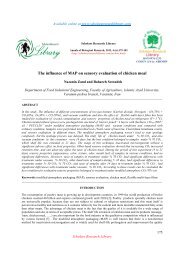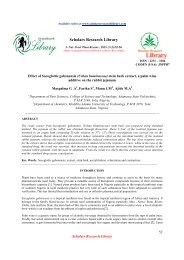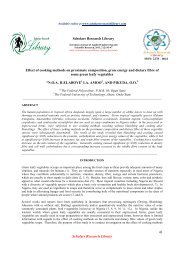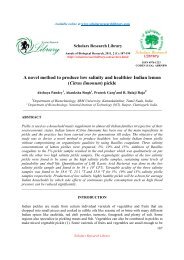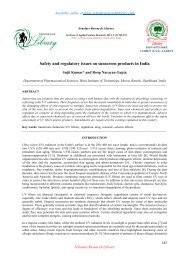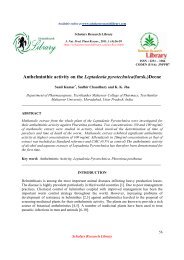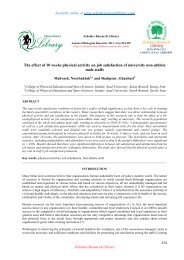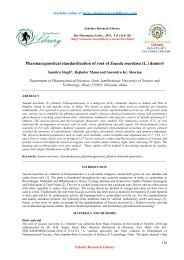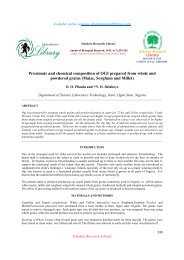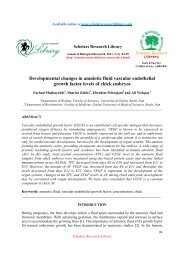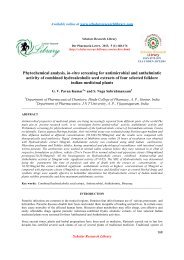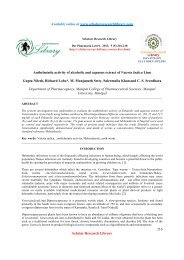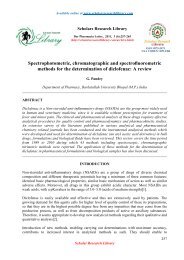Anthelmintic activity of Cassia auriculata L. extracts-In vitro study
Anthelmintic activity of Cassia auriculata L. extracts-In vitro study
Anthelmintic activity of Cassia auriculata L. extracts-In vitro study
You also want an ePaper? Increase the reach of your titles
YUMPU automatically turns print PDFs into web optimized ePapers that Google loves.
Sucheta A Gaikwad et al J. Nat. Prod. Plant Resour., 2011, 1 (2): 62-66<br />
______________________________________________________________________________<br />
CONCLUSION<br />
It is concluded based on the findings <strong>of</strong> the present <strong>study</strong> that the leaves <strong>of</strong> <strong>Cassia</strong> <strong>auriculata</strong> L.<br />
possess varying degree <strong>of</strong> anthelmintic activities. The dose <strong>of</strong> the extract is increased, a gradual<br />
increase in the <strong>activity</strong> <strong>of</strong> <strong>extracts</strong> is dose dependent.(GraphI) Quath and ethanol <strong>extracts</strong><br />
exhibited significant anthelmintic <strong>activity</strong> at C.<strong>auriculata</strong> highest concentration <strong>of</strong> 20 mg/ml.<br />
This <strong>study</strong> strongly supports the traditional use <strong>of</strong> leaves as anthelmintic.<br />
Acknowledgement<br />
The authors are thankful to the Principal, S.P.College and Head, Department <strong>of</strong> Chemistry,<br />
S.P.College, Pune-30 for providing experimentation facilities.<br />
REFERENCES<br />
[1] William o Foye, Principles <strong>of</strong> Medicinal Chemistry, Varghese Publishing House, Bombay,<br />
Third Edition year pg 726-730<br />
[2] Aswar Manoj, Aswar Urmila,Watkar Bhagyashri.,et al. <strong>In</strong>t J Green Pharm,170-173,( 2008)<br />
[3]Bundy D. A., Trans Royal Soc Trop Med Hyg, 1994, 8, 259-261.<br />
[4]Tagbota S, Townson S., Adv Parasitol, 2001, 50,199-205.<br />
[5]Sondhi, S.M., Shahu, R., Magan Archana, <strong>In</strong>dian Drugs, 1994, 31(7), 317-320.<br />
[6]Nadkarni A.K., <strong>In</strong>dian Material Medica, Popular Prakashan Pvt. Ltd. Bombay., 1954, Vol. I,<br />
168.<br />
[7]Satish B. Kosalge, Ravindra A. Fursule, <strong>In</strong>ternational Journal <strong>of</strong> Pharm Tech Research<br />
Vol.1,No.1,pp 68-72, Jan – March 2009<br />
[8]Dash G. K., Suresh P, Kar D. M., Ganpaty S., Panda S. B., J Nat Rem, 2002, 2, 182-185<br />
[9]Bate-Smith EC., J Soc Bot, 58: 95-103,(1962).<br />
[10]Martin RJ., Vet J, 154:11-34, 1997<br />
[11]Mali R.G., Wadekar R.R., <strong>In</strong>dian J Pharm Sci. 2008, Jan-Feb, 131-133<br />
[12].Kokate CK.Practical Pharmacognosy, 4 th edn, Vallabha Prakashan, New Delhi, 149-156,<br />
(1999).<br />
[13]Khandelwal KR. Practical Pharmacognosy Technique and Experiments, 2nd edn, Nirali<br />
Prakashan, Pune, 149-56, (2000).<br />
[14] Ajaiyeoba EO, Onocha PA, OlarenwajuOT., Pharm Biol, 39:217- 220,(2001).<br />
[15] Deore SL, Khadabadi SS, Kamdi KS. et al. <strong>In</strong>t J Chem Tech Res, 1: 177-179,(2009)..<br />
Scholar Research Library<br />
66



